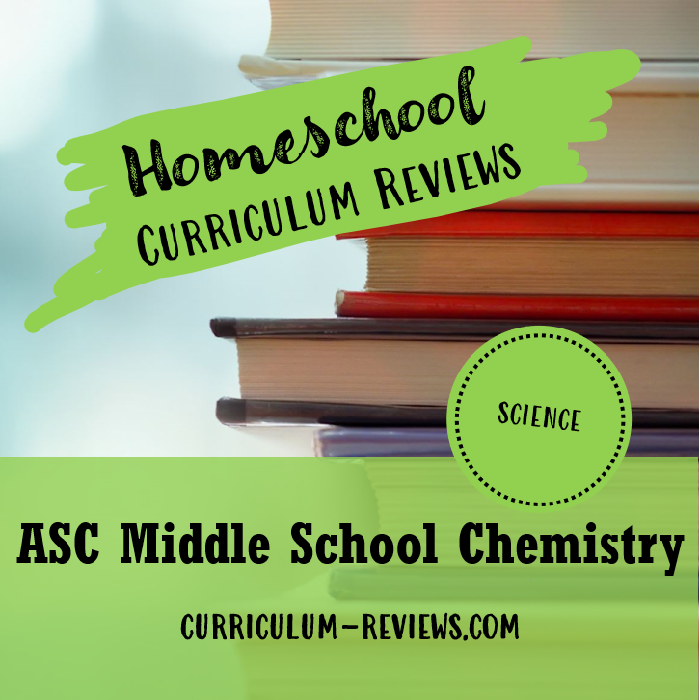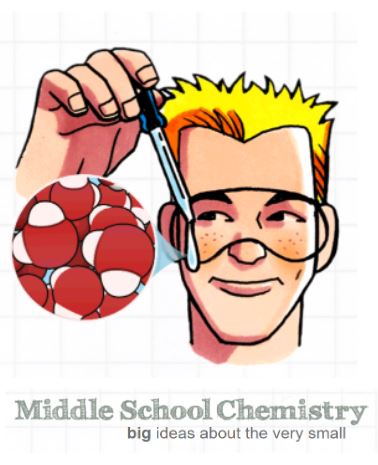
ASC Middle School Chemistry

Target Grade Level: 6th – 8th
Middle School Chemistry from the American Chemical Society is my favorite homeschooling find of the year. It’s their free offering to schools and individuals, and it is science education at its best. After a rather ho-hum run through Real Science 4 Kids Chemistry I, my younger and I were looking for more chemistry to learn. He wanted plenty of hands-on time but without the dangerous chemicals (sulphuric acid, hydrochloric acid, and other nasties) the older boys were using for their high school chemistry class. I was in agreement and actively searching for the next step when the ACS Middle School Chemistry curriculum appeared on an email list.
Middle School Chemistry is inquiry based science, meaning that rather than starting a lesson with terms and definitions, each lesson starts with questions. Generally, a demonstration follows that leads to further thinking on the concept, which is followed by an experiment, sometimes requiring the child to make decisions on the design. In the second lesson, a discussion of variables and controls provides language for experiment design. Additional experimental design guidance appear throughout the following chapters. Terms and concepts are discussed after demonstrations and experiments. Nothing is taught out of context. For every concept, the student has watched the result of the concept and experimented with the process. Thus a student has working knowledge of the concept even before it has a name. This is not, “Oh, look at that!” science. Rather this is, “So that’s how that works!” science.
That’s the idea of inquiry learning. What does it look like in practice? Chapter 2.3 focuses on condensation. By this point, the student understands that molecules are in motion and that increasing heat increases molecular motion. They’ve experimented with these principles and watched brief animations of simple diagrams of molecules in motion. In the lesson on state changes (going from solid, to liquid, to gas and the reverse), the student first watches the state change occurs in an experiment demonstration. In this lesson, a glass of ice water left on the counter is compared with a glass of ice water enclosed in a plastic bag with much of the air pushed out. The student can observe the higher level of moisture on the outside of the glass exposed to the air and can surmise that water came from the air. Simple stuff, right?
But the focus of the unit is molecular movement and energy transfer. As the water molecules in the gaseous state lose energy to the cold glass (heat transfer/energy transfer), they move to the liquid state. Often the movement of molecules is left until higher level chemistry. So while a younger child may memorize the order of the state changes, the idea that the varying speed of the molecules (and more) is what determines a solid, liquid, or gas, is often omitted. But not in Middle School Chemistry. In this lesson, condensation examples are elicited from the students and discussed. The process is observed as well. After discussing experimental design, the student does an experiment to determine what temperature conditions accelerate condensation. Online short animations model the molecular motion at each stage, and knowledge can be extended to water purification experiments and exploration of other factors that influence that state change of water. Plenty of questions for the student to answer on paper or aloud as the lesson proceeds gives sufficient opportunity to process and retain the new information. Since each lesson builds on the one before, older information is continually used and expanded beyond.
This isn’t science as it is usually taught. It’s certainly not science as I learned it in school. The National Research Council defines inquiry science this way:
Scientific Inquiry refers to the diverse ways in which scientists study the natural world and propose explanations based on the evidence derived from their work. Inquiry also refers to the activities of students in which they develop knowledge and understanding of scientific ideas, as well as an understanding of how scientists study the natural world. (From Doing Science: The Processes of Scientific Inquiry — this link takes you to an NIH curriculum supplement on Inquiry Science for grades 6 – 8.
This isn’t science as recommended as by The Well Trained Mind and other classical education models. And it’s not the process of teaching science used by any homeschool science programs I’ve found (although Nebel offers a fine elementary curriculum for grade K-5). Singapore Science does contain some inquiry, but the labs are somewhat challenging for homeschoolers. ACS’s Middle School Chemistry is chemistry taught from the roots up, with molecular motion and activity at the core. It’s by far the best accessible chemistry program I’ve seen for elementary or middle schoolers. And it’s free.
All the materials can be printed or read from their online side or downloaded to any device that reads PDF files. I print out the student pages (4 to 7 pages per lesson) and teach from the book on my iPad. There are also 6 to 10 pages of printable text for the child for each of the six chapters, which I’ve assigned my son to read at the end of the chapter. These short, illustrated chapters are fine summaries of the material learned and supplement the lessons nicely, and they are designed to do just that — summarize what has been learned during the inquiry and discovery lesson. This is a teacher/parent intensive program (meaning you can’t just hand it to your child and let them plug away — discussion is part of the game), but preparation is minimal. Most importantly, my nine-year-old is learning chemistry in a deep, meaningful way. He’s learning to design an experiment to answer his own questions, complete with correctly identified variables and controls. He’s learning a number of lab skills at an early age.
I’d recommend the American Chemical Society’s Middle School Chemistry to anyone with a later elementary or middle-school aged child who is willing to walk together with their child through chemistry. I’d guess plenty of parents can learn quite a bit about matter and how the molecular world works, and this program makes it fun. While it’s written for the 6th though 8th grade crew, it could definitely be used younger with a quick learner interested in science. It’s suitable for co-op use. There is a small amount of math involved in the course, but comfort with fractions and decimals (needed when figuring densities) is sufficient. There is sufficient material to spread the course over a year, as one might in a co-op setting, although we preferred to devour it more quickly (“Can we do Chemistry, Mom? Please!”).
Middle School Chemistry from ACS uses simple, safe, and easily obtainable materials. While these lists may seem long, you probably have many of the ordinary materials on the second list on hand. All the materials on the not-so-ordinary list can be used for later chemistry studies.
Some of the not-so-ordinary materials you’ll need, include: Scientific thermometers, density cubes, graduated cylinders, and calcium chloride.
 About the Author: Middle School Chemistry was developed and written by Jim Kessler, Patti Galvan, and Adam M. Boyd at the American Chemical Society. Patti worked as an elementary school teacher with a keen interest in science education before coming to ACS. Jim was a high school science teacher and has been developing resources for K–8 teachers for 20 years. Adam’s areas of expertise include chemistry, writing, and the web.
About the Author: Middle School Chemistry was developed and written by Jim Kessler, Patti Galvan, and Adam M. Boyd at the American Chemical Society. Patti worked as an elementary school teacher with a keen interest in science education before coming to ACS. Jim was a high school science teacher and has been developing resources for K–8 teachers for 20 years. Adam’s areas of expertise include chemistry, writing, and the web.

